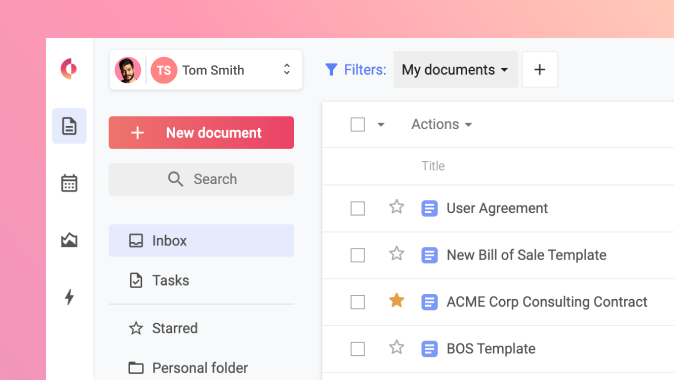4 Key Contract Compliance Guidelines
Whether it’s Legal or Sales, it’s important for every team to ensure they’re supporting strong contract compliance.
Contracts alone help increase compliance. But within a contract, there’s a lot more that can be done to enhance an organization’s compliance. Whether it’s through features in a contract management platform or the way the contract process is conducted, it’s important to be aware of where the possibilities of risk are. It is also crucial to know how they can be alleviated. Here are the top ways a company can be sure their contracts are a tool for mitigating risk, not creating it.
Templates
The first step is creating templates for employees to use. Yet while most companies have templates for users to work from, whether or not they use them is a different story.
Keeping templates in the same place where people are creating documents is key to ensuring compliance. For example, working from a contract lifecycle management platform, not from a repository where templates get out of date. A single source of truth for documents and processes is key to compliance. In this case, it can mean the difference between an updated clause that’s compliant, or an outdated version that gets the company into legal trouble.
Templates don’t just mitigate risk — they make it easier for all parties to comply with the rules and progress business faster. While everyone should be mindful of compliance regardless of how easy it is, making the process simpler for users increases the adoption of new rules and regulations.
Contract Approval Workflows
Even if a contract is from a template, negotiations are often part of the process. This changes certain clauses and terms from their original form. If this is the case, each legal department still needs to review the final version before approval.
In the past, this often looked like repeated emails asking Legal to look at a document. It could even mean having to track down someone in person. Contract approval workflows not only make the process easier for the user, but they ensure compliance. They do this by not allowing a contract to continue forward in the process unless the right parties approve. In another step that makes compliance easier to adopt, approval workflows are preset so that everyone who approves a contract gets added.
Relationships
The contract is just the first step in beginning a successful business relationship. Negotiation and working through the process together to ensure the best deal possible strengthen the initial connection between two organizations.
Tension and conflict where one side feels unheard or disrespected are likely to end in unhappy partners and legal battles. Even if a deal starts to go south, having cordial relationships that are functional for working situations goes a long way in keeping the peace.
Communication
Part of maintaining good relationships is through healthy communication. Companies often want to hold off on bad news or ignore small issues that arise in order to keep the image of a good deal on the surface. Yet addressing these things immediately can alleviate tension if anything does go awry. It also builds trust for the future, as the other party feels assured they will be notified if anything is amiss.
In addition to this communication, planning is key to making sure the other party knows what situation to expect. This is especially true if things don’t always go as planned. While it’s important to address anything that is veering from the original plan, it’s also important to let the other party know how it will be resolved.
Even if one side has to be the bearer of bad news, knowing that they are working on a way to make things right helps the other side feel listened to and respected. Good communication increases compliance as all sides feel comfortable addressing any issue without escalating it immediately to a legal battle.
Communication is also vital when it comes to negotiation, rules, and regulations. With online redlining, editing, and comments, users can adjust the original terms while informing the other party of the reason for the conditions. Both sides can ensure they are maintaining compliance with the rules within their organization and region with simple, thorough communication.
Contract Compliance in Summary
Contract compliance is one of the most important aspects of a contract to prioritize. From the very first draft all the way through to renewals and a continued relationship, it all matters. Ensuring these four things are a part of every contract lifecycle will help an organization mitigate risk and thrive.




